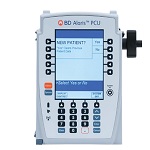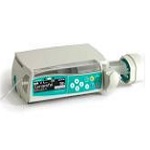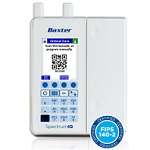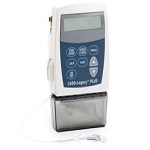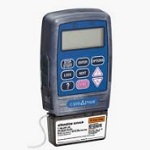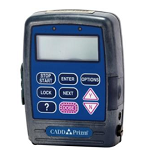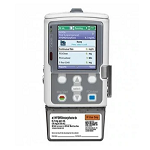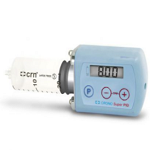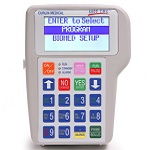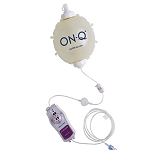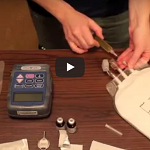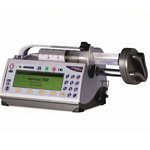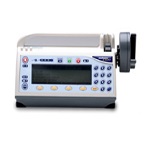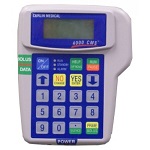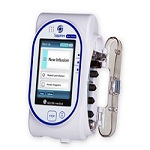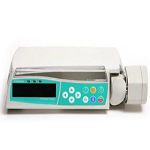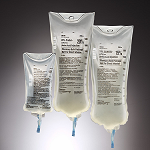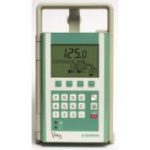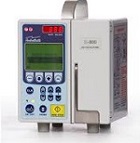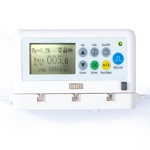
Select Instructions for IV Pumps
An infusion pump is a medical device that delivers fluids, such as nutrients and medications, into a patient’s body in controlled amounts. Infusion pumps are in widespread use in clinical settings such as hospitals, nursing homes, and in the home. Infusion pump delivers measured am fluids or medications into the blood over a period of time. They supply a controlled amount of slowly into the bloodstream over a p time. One method is peristaltic rollers on a drum squeeze the fluid tu controlled manner to force the fluid d tubing.
Select Instructions From the List Below
Alaris – IV Pump Instructions
Alaris™ Pump The BD Alaris™ PC unit is the foundation of a modular platform that lets you customize Read more...
B Braun Syringe Pump Instructions
Perfusor Space Syringe Pump The first syringe pump to include air and road transport in the 510(k) cleared Read more...
Baxter Sigma Spectrum Infusion Pump
Baxter Sigma Spectrum IQ Infusion System With Dose IQ Safety Software is intelligently designed to simplify integration Read more...
CADD 6500 IV Pump Instructions
CADD Legacy Plus Pump The Legacy Plus Model 6500 is the new member of the CADD Read more...
CADD PRIZM 6101 – TPN IV Setup
CADD PRIZM 6101 - TPN IV Setup The CADD-Prizm pump is indicated for intravenous, intra-arterial, subcutaneous, intraperitoneal, Read more...
CADD Prizm IV Pump Instructions
CADD® Ambulatory Infusion Systems, The CADD-Prizm® pump is indicated for intravenous, intra-arterial, subcutaneous, intraperitoneal, epidural space, or Read more...
CADD®-Solis Ambulatory Infusion Pump Instructions
CADD®-Solis Ambulatory Infusion Pump with Wireless Communications Wireless communication transforms the CADD®-Solis system from a Read more...
Crono Super-PID subcutaneous pump Instructions
Crono Super PID Ambulatory Syringe Infusion Pump The Crono Super PID is an ambulatory syringe infusion pump Read more...
Curlin pump TPN setup Instructions
CURLIN MEDICAL PUMP - TPN The Curlin Medical 6000. CMS Pump is considered as a multi-therapy infusion Read more...
Elastomeric IV Pump Systems – Instructions
ON-Q PainBuster Post-Op Pain Relief System. ON-Q painbuster pump provides continuous infusion of a local anesthetic directly Read more...
Hospira GemStar Infusion System
GemStar™ Infusion System From pain management to ambulatory infusions and anywhere in between, the GemStar™ infusion system Read more...
How to prepare and administer TPN Instructions
TPN Administered TPN administration into a vein, generally through a PICC (peripherally inserted central catheter) Read more...
Medfusion 3500 Syringe Pump Instructions
Medfusion 3500 Syringe Pump Designed to enhance safety while maintaining simplicity to deliver individualized care to patients Read more...
Medfusion® 3500 Syringe Pump
Medfusion™ 3500 Syringe Pump The Medfusion™ 3500 Syringe Pump is an intuitive system designed to enhance safety Read more...
MOOG Medical, Curlin 4000 CMS IV Pump
MOOG Medical, Curlin 4000 CMS The 4000 Clinical Management System (CMS) is multi-therapy ambulatory electronic infusion pump Read more...
Sapphire Infusion Pump Instructions
Sapphire™ infusion system This unique patented technology, innovative design and intuitive touch screen, the Sapphire Read more...
The Perfusor Space 2nd Generation Syringe Pump
The Perfusor® Space 2nd Generation Syringe Pump The Perfusor® Space 2nd Generation Syringe Pump is the first syringe pump Read more...
TPN Setup with IV pump Instructions
TPN stands for Total Parenteral Nutrition. Healthy individuals get their nutrition via the digestive tract, Read more...
Vista® basic Infusion Pump Instructions
Vista Infusion Pump UPC: 637-202 B. Braun pump sets offer comprehensive standard and Design Options® lines of disposables, Read more...
Z-800F – Zyno Medical Ambulatory Infusion System
Zyno Medical's Z-800 F infusion pump Zyno Medical's Z-800 F infusion pump was created in response to Read more...
Zyno Medical Nimbus™ Ambulatory Infusion System Instructions
Nimbus™ II Flex Nimbus™ II Flex is a sleek and cutting-edge ambulatory infusion pump. It affords the Read more...
MedExplains AI Content
How to setup and maintain infusion pump is a medical device that delivers fluids?
1. Preparation
- Gather Supplies: Infusion pump, IV tubing, prescribed fluid/medication, antiseptic wipes, gloves, and any other necessary equipment.
- Wash Hands: Always wash your hands thoroughly before handling the infusion pump or related equipment.
- Check Equipment: Inspect the infusion pump and tubing for any damage or defects.
2. Setting Up the Infusion Pump
- Prime the Tubing:
- Attach the IV tubing to the fluid bag.
- Hang the fluid bag on an IV pole.
- Open the tubing clamp to allow fluid to flow through, pushing out any air bubbles (this is called priming the tubing).
- Close the clamp once the tubing is filled with fluid.
- Load the Tubing into the Pump:
- Open the pump’s door or cassette.
- Insert the primed tubing into the designated slot or cassette.
- Close the pump’s door securely.
- Program the Infusion Pump:
- Turn on the infusion pump.
- Enter the prescribed infusion rate, volume to be infused, and any other settings as directed by the healthcare provider.
- Double-check all settings for accuracy.
3. Connecting the Infusion Pump to the Patient
- Prepare the IV Site:
- Clean the insertion site with an antiseptic wipe.
- Attach the IV tubing to the patient’s IV catheter.
- Start the Infusion:
- Open the tubing clamp.
- Press the “Start” button on the infusion pump.
- Monitor the infusion site for any signs of discomfort, swelling, or redness.
4. Monitoring and Maintenance
- Monitor the Pump: Regularly check the infusion pump to ensure it is running correctly and delivering fluids at the prescribed rate.
- Check the Site: Inspect the IV site periodically for signs of infection or infiltration.
- Respond to Alarms: If the pump alarms, address the issue promptly—whether it’s air in the line, occlusion, or a low battery.
- Document: Record the infusion details, including start time, rate, and any observations.
5. Troubleshooting Common Issues
- Air in Line: Re-prime the tubing if you notice air bubbles.
- Occlusion: Check for kinks in the tubing or issues with the IV site.
- Low Battery: Plug in the pump to recharge or replace the battery as needed.
6. After Use
- Disconnect: Once the infusion is complete, clamp the tubing and carefully disconnect it from the patient.
- Dispose of Materials: Dispose of used IV bags, tubing, and other disposables according to medical waste protocols.
- Clean the Pump: Wipe down the infusion pump with a disinfectant.
- Store Properly: Store the infusion pump and remaining supplies in a clean, dry area.
Proper setup and maintenance of an infusion pump are crucial for patient safety and effective treatment. Always follow the specific instructions provided by the pump manufacturer and healthcare provider.
Select Instructions From the List Below
Alaris – IV Pump Instructions
Alaris™ Pump The BD Alaris™ PC unit is the foundation of a modular platform that lets you customize Read more...
B Braun Syringe Pump Instructions
Perfusor Space Syringe Pump The first syringe pump to include air and road transport in the 510(k) cleared Read more...
Baxter Sigma Spectrum Infusion Pump
Baxter Sigma Spectrum IQ Infusion System With Dose IQ Safety Software is intelligently designed to simplify integration Read more...
CADD 6500 IV Pump Instructions
CADD Legacy Plus Pump The Legacy Plus Model 6500 is the new member of the CADD Read more...
CADD PRIZM 6101 – TPN IV Setup
CADD PRIZM 6101 - TPN IV Setup The CADD-Prizm pump is indicated for intravenous, intra-arterial, subcutaneous, intraperitoneal, Read more...
CADD Prizm IV Pump Instructions
CADD® Ambulatory Infusion Systems, The CADD-Prizm® pump is indicated for intravenous, intra-arterial, subcutaneous, intraperitoneal, epidural space, or Read more...
CADD®-Solis Ambulatory Infusion Pump Instructions
CADD®-Solis Ambulatory Infusion Pump with Wireless Communications Wireless communication transforms the CADD®-Solis system from a Read more...
Crono Super-PID subcutaneous pump Instructions
Crono Super PID Ambulatory Syringe Infusion Pump The Crono Super PID is an ambulatory syringe infusion pump Read more...
Curlin pump TPN setup Instructions
CURLIN MEDICAL PUMP - TPN The Curlin Medical 6000. CMS Pump is considered as a multi-therapy infusion Read more...
Elastomeric IV Pump Systems – Instructions
ON-Q PainBuster Post-Op Pain Relief System. ON-Q painbuster pump provides continuous infusion of a local anesthetic directly Read more...
Hospira GemStar Infusion System
GemStar™ Infusion System From pain management to ambulatory infusions and anywhere in between, the GemStar™ infusion system Read more...
How to prepare and administer TPN Instructions
TPN Administered TPN administration into a vein, generally through a PICC (peripherally inserted central catheter) Read more...
Medfusion 3500 Syringe Pump Instructions
Medfusion 3500 Syringe Pump Designed to enhance safety while maintaining simplicity to deliver individualized care to patients Read more...
Medfusion® 3500 Syringe Pump
Medfusion™ 3500 Syringe Pump The Medfusion™ 3500 Syringe Pump is an intuitive system designed to enhance safety Read more...
MOOG Medical, Curlin 4000 CMS IV Pump
MOOG Medical, Curlin 4000 CMS The 4000 Clinical Management System (CMS) is multi-therapy ambulatory electronic infusion pump Read more...
Sapphire Infusion Pump Instructions
Sapphire™ infusion system This unique patented technology, innovative design and intuitive touch screen, the Sapphire Read more...
The Perfusor Space 2nd Generation Syringe Pump
The Perfusor® Space 2nd Generation Syringe Pump The Perfusor® Space 2nd Generation Syringe Pump is the first syringe pump Read more...
TPN Setup with IV pump Instructions
TPN stands for Total Parenteral Nutrition. Healthy individuals get their nutrition via the digestive tract, Read more...
Vista® basic Infusion Pump Instructions
Vista Infusion Pump UPC: 637-202 B. Braun pump sets offer comprehensive standard and Design Options® lines of disposables, Read more...
Z-800F – Zyno Medical Ambulatory Infusion System
Zyno Medical's Z-800 F infusion pump Zyno Medical's Z-800 F infusion pump was created in response to Read more...
Zyno Medical Nimbus™ Ambulatory Infusion System Instructions
Nimbus™ II Flex Nimbus™ II Flex is a sleek and cutting-edge ambulatory infusion pump. It affords the Read more...
